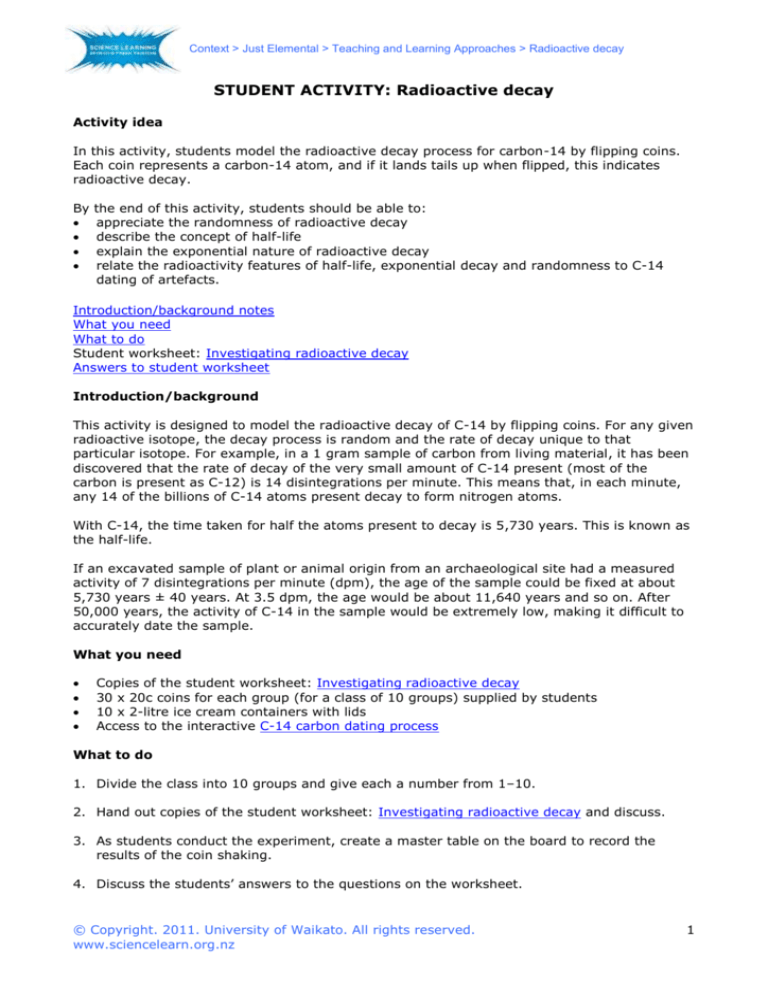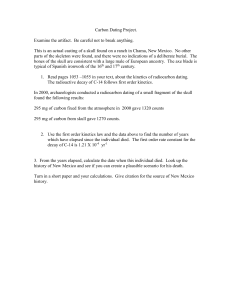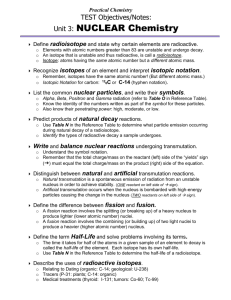
Context > Just Elemental > Teaching and Learning Approaches > Radioactive decay
STUDENT ACTIVITY: Radioactive decay
Activity idea
In this activity, students model the radioactive decay process for carbon-14 by flipping coins.
Each coin represents a carbon-14 atom, and if it lands tails up when flipped, this indicates
radioactive decay.
By
the end of this activity, students should be able to:
appreciate the randomness of radioactive decay
describe the concept of half-life
explain the exponential nature of radioactive decay
relate the radioactivity features of half-life, exponential decay and randomness to C-14
dating of artefacts.
Introduction/background notes
What you need
What to do
Student worksheet: Investigating radioactive decay
Answers to student worksheet
Introduction/background
This activity is designed to model the radioactive decay of C-14 by flipping coins. For any given
radioactive isotope, the decay process is random and the rate of decay unique to that
particular isotope. For example, in a 1 gram sample of carbon from living material, it has been
discovered that the rate of decay of the very small amount of C-14 present (most of the
carbon is present as C-12) is 14 disintegrations per minute. This means that, in each minute,
any 14 of the billions of C-14 atoms present decay to form nitrogen atoms.
With C-14, the time taken for half the atoms present to decay is 5,730 years. This is known as
the half-life.
If an excavated sample of plant or animal origin from an archaeological site had a measured
activity of 7 disintegrations per minute (dpm), the age of the sample could be fixed at about
5,730 years ± 40 years. At 3.5 dpm, the age would be about 11,640 years and so on. After
50,000 years, the activity of C-14 in the sample would be extremely low, making it difficult to
accurately date the sample.
What you need
Copies of the student worksheet: Investigating radioactive decay
30 x 20c coins for each group (for a class of 10 groups) supplied by students
10 x 2-litre ice cream containers with lids
Access to the interactive C-14 carbon dating process
What to do
1. Divide the class into 10 groups and give each a number from 1–10.
2. Hand out copies of the student worksheet: Investigating radioactive decay and discuss.
3. As students conduct the experiment, create a master table on the board to record the
results of the coin shaking.
4. Discuss the students’ answers to the questions on the worksheet.
© Copyright. 2011. University of Waikato. All rights reserved.
www.sciencelearn.org.nz
1
Context > Just Elemental > Teaching and Learning Approaches > Radioactive decay
Investigating radioactive decay
1. Your teacher will give your group a number – circle this on the results table below.
2. Put 30 coins in the ice cream container and replace the lid. Shake the container for 5
seconds and carefully remove the lid. The coins will have settled out as either a head or a
tail. Carefully remove all of the tails and count the number of heads that remain.
3. Record your result in the table below under your group number, and record other groups’
results under their group numbers.
4. Add up the results and complete the ‘Total C-14 remaining’ column.
5. In the decay grid, randomly shade the appropriate number of boxes that correspond to the
total column in the table above. For example, if there are 243 C-14 atoms remaining, 57
boxes should be shaded.
6. Repeat steps 1–4 with the remaining coins until five shaking cycles have been completed.
Results table
Time
period
0
1
2
3
4
5
1
30
2
30
3
30
4
30
Group
5
6
30
30
7
30
8
30
9
30
10
30
Total C-14
remaining
300
Decay grid
Each clear box represents a C-14 atom. By shading a box, this indicates that C-14 has decayed
to nitrogen by particle emission.
© Copyright. 2011. University of Waikato. All rights reserved.
www.sciencelearn.org.nz
2
Context > Just Elemental > Teaching and Learning Approaches > Radioactive decay
7. Plot the results table on the graph below. The vertical axis is C-14 atoms remaining and
the horizontal axis is the time period. Draw a curve through the points you have plotted.
8. Compare the graph you have drawn above with this graph from the NZ Research article
Carbon-14 dating artefacts. What is your conclusion?
© Copyright. 2011. University of Waikato. All rights reserved.
www.sciencelearn.org.nz
3
Context > Just Elemental > Teaching and Learning Approaches > Radioactive decay
9. Answer the following questions:
a. How is C-14 produced in the Earth’s upper atmosphere?
b. When a C-14 atom undergoes radioactive decay, what does it decay into?
c. How do C-14 atoms get into living material?
d. If all humans living today have radioactive C-14 present in their bodies, why do they not all
suffer from radiation damage?
e. Over what time range is the C-14 dating of artefacts such as bone fragments reliable?
View the C-14 carbon dating process interactive and answer the following questions.
f.
What must the piece of moa bone contain before it can be successfully dated using the C14 method?
g. After initial cleaning and chemical processing, the remaining bone material is subjected to
a series of chemical steps. These steps are shown in the diagram below. Beneath each of
the chemical formulas, write in the name of the chemical.
combustion
lithium
water
catalyst
C + O2
CO2
Li2C2
C2H2
C6H6
h. How does the scintillator chemical (butyl-BPD) that is added to the C6H6 work?
© Copyright. 2011. University of Waikato. All rights reserved.
www.sciencelearn.org.nz
4
Context > Just Elemental > Teaching and Learning Approaches > Radioactive decay
i.
Explain how the radiocarbon age established through analysis of the results from the liquid
scintillation spectrometer is converted to a calendar age for the sample.
j.
The moa bone analysis gave a radiocarbon date of 580 years plus or minus 40 years. The
calendar age was established at AD 1390–1435. What does AD stand for?
© Copyright. 2011. University of Waikato. All rights reserved.
www.sciencelearn.org.nz
5
Context > Just Elemental > Teaching and Learning Approaches > Radioactive decay
Answers to student worksheet
a. How is C-14 produced in the Earth’s upper atmosphere?
Neutrons present in cosmic radiation that bombards the Earth’s upper atmosphere are
captured by nitrogen atoms. This results in the production of C-14 atoms.
14
+ 0n1 6C14 + 1H1
7N
b. When a C-14 atom undergoes radioactive decay, what does it decay into?
Radioactive decay of C-14 involves the ejection of a particle leaving behind a nitrogen
atom. 6C14 7N14 + -10
c. How do C-14 atoms get into living material?
Once formed, the C-14 reacts with oxygen to form 14CO2. This enters the carbon cycle,
circulating through the atmosphere, oceans and biosphere. Plants absorb the CO 2 and
convert it to organic compounds, and in this way, C-14 becomes incorporated into living
tissue. When the plant dies, C-14 will no longer be taken up. Radioactive decay still
continues, however, with the C-14 activity decreasing over time.
d. If all humans living today have radioactive C-14 present in their bodies, why do they not all
suffer from radiation damage?
Carbon is about 23% of the body weight. Only a very, very small percentage of this carbon
is made up of C-14 – about 1.6 x 10-8 g. This very small dose poses little threat to the
body.
e. Over what time range is the C-14 dating of artefacts such as bone fragments reliable?
Pre-1950 samples that are less than 100 years old or older than 60,000 years cannot be
accurately dated. The reason for this has to do with the concentration of C-14 in living
materials as well as the half-life of the C-14 isotope.
f.
What must the piece of moa bone contain before it can be successfully dated using the C14 method?
Protein must be present.
g. After initial cleaning and chemical processing, the remaining bone material is subjected to
a series of chemical steps. These steps are shown in the diagram below. Beneath each of
the chemical formulas, write in the name of the chemical.
combustion
lithium
water
catalyst
C + O2
CO2
Li2C2
C2H2
C6H6
carbon dioxide
lithium carbide
acetylene
benzene
h. How does the scintillator chemical (butyl-BPD) that is added to the C6H6 work?
The C-14 atoms present in the benzene decay at a certain rate. The scintillator chemical
butyl-PBD picks up each decay event and emits a tiny flash of light that the spectrometer is
programmed to detect and count. In addition to the moa sample, control samples are also
measured at the same time. The decay events for each sample are measured over a week.
i.
Explain how the radiocarbon age established through analysis of the results from the liquid
scintillation spectrometer is converted to a calendar age for the sample.
The results from the liquid scintillation spectrometer are carefully analysed and provide a
radiocarbon age for the sample. To obtain a calendar age for the sample, this radiocarbon
age needs to be compared against samples of known age by means of a calibration curve
using a specially designed computer software application. This application uses a terrestrial
calibration curve to calculate the calendar age.
j.
The moa bone analysis gave a radiocarbon date of 580 years plus or minus 40 years. The
calendar age was established at AD 1390–1435. What does AD stand for?
AD stands for ‘Anno Domini’ which translated means ‘ in the year of our Lord’. It means the
number of years since the time of Jesus Christ. To avoid Christian references, AD is often
replaced with CE which means ‘common era’. AD 1390 can be written as CE 1390.
© Copyright. 2011. University of Waikato. All rights reserved.
www.sciencelearn.org.nz
6







